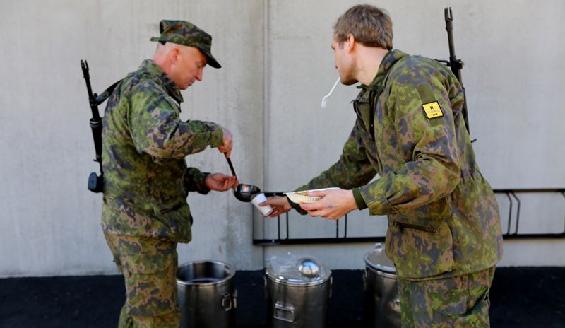Ruska 2016 Kicks Off
Ruska 2016 air operations exercise is the biggest tactical training event of the Air Force of the year. Its primary objective is to train service units as components of a major air operation. Reservists have a key role in the exercise, which involves over fifty aircraft and approximately 2,600 airmen. Swedish Air Force assets also contribute to the event.
Ruska is called an air operations exercise. What is an air operations exercise?
Defensive operations include land, air, and maritime operations. The aim of air operations is to negate aerial attacks and strike at the attacker's vital ground-based assets and functions. In this exercise, air operations employ air-to-air, air-to-ground, and surface-to-air weapon systems,
The Air Force is fielding a new battle concept. How is this apparent in Ruska?
The new battle concept is first and foremost about being deployable. Deployability enhances the combat endurance of our bases, and of command and control and surveillance systems. By redeploying our assets we try to make it harder for the attacker to anticipate our moves and determine the disposition of our units. At our bases, the new concept manifests itself as relocating of units within base premises. Various measures aimed at enhancing protection and reducing vulnerability are also put to a test in the exercise.
Aircraft are the most visible air defense assets, both on the ground and in the air. What other components contribute to a total air defense effort?
An extensive organization is needed to bring the capabilities of our multirole combat aircraft to bear. All components of this organization are essential for the efficacious employment of the fighters. A planning and command part works in cooperation with the other two services and produces guidelines that enable the coordinated execution of operations. Intelligence provides information of the attacker's activities. Information from radars and other sensors is used to create an air picture for the management of air operations. Navy vessels fill in this air picture with shipborne sensors. A logistic system ensures that the units have necessary material, and aircraft are kept airworthy and appropriately equipped. To enable successful air operations, key ground-based assets and functions need to be defended; therefore, surface-based air defense systems provide additional protection of the nation's vital assets and military forces.
Large numbers of reservists have been called up. What is their role in the exercise and in the air defense effort?
Reservists have a decisive role in the total air defense effort. Should a crisis develop, reservists trained in all air defense specialties will be called up for service, with the exception of aircrew member duties. The reservists' ability to maintain and improve their existing high skills in even the most demanding tasks never ceases to amaze.
In the ongoing exercise, reservists undertake a full range of aircraft maintenance, force protection, surface-based air defense, air surveillance, logistic, and command and control duties.
What are the Ruska objectives as seen from the standpoint of total air defense effort?
Its primary objective is to train service units as components of a major air operation. With the exercise, we ensure that the total air defense effort can be carried out with success at all organizational levels, starting at the planning phase and culminating at execution. This must be a controlled process from the national level down to each battle base.
The objective of air operations is to safeguard the citizens' living conditions and protect the nation's vital assets against air attacks, and to enable the conduct of land and maritime operations. The results of Ruska 2016 air operations will eventually be assessed against these objectives of the total air defense effort.
This is the first time that the Swedish Air Force contributes to a Ruska exercise. What is Flygvapnet's role in the exercise, and what benefits does its involvement bring?
Flygvapnet's Gripens play red air with Finnish Hawks and Hornets by replicating the capabilities of modern airborne weapon systems to present challenging targets to blue force.
Unfamiliar aircraft types always add to the challenge and lessen predictability in air combat. Even though we train with the Swedes almost on a weekly basis, there is always something new to learn, and that works both ways.
Long-term benefits of combined training are improvements in the interoperability of command and control systems, standard operating procedures, and air base functions.

Around 1,600 reservists have been called up for Ruska 2016.
Read more: Ruska 2016 in October Set to Be This Year's Major Live Air Exercise



